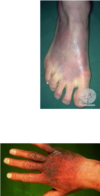Zoonoses Flashcards
what is zoonoses?
- Infections that can pass between living animals and humans
- The source of the disease is from the animal
- WHO definition: Infections that are naturally transmitted between vertebrate animals and humans
- Malaria
- Schistosomiasis (Snail fever)
- Oncoceriasis (River Blindness)
- Elephantiasis (Lymphatic Filariasis)
Are these zoonoses? if so why not?
Because even though transmitted from animals, they depend on the human host for part of their life-cycle
What is Anthroponosis?
‘Reverse zoonoses’ in that humans are infecting animals
What are examples of Anthroponosis?
Influenza (virus affecting birds, pigs)
‘Strep throat’ (bacteria affecting dogs)
Leishmaniasis (parasite affecting dogs e.g.)
Chytridiomycosis (fungus affecting amphibians)
what can Zoonoses be?
Can be caused by virus, bacteria, parasites or fungi
Pathogens have developed strategies to ensure their own survival/propagation, how?
causing a chronic infection to survive
or have a non-human reservoir
List of zoonoses (partial) - bacteria
Salmonella
Campylobacter
Shigella
Anthrax
Brucella
E-coli (verotoxigenic)
Leptospirosis
Plague
Psittacosis (Ornitosis)
Q fever
Tularaemia
List of zoonoses (partial) - viruses
Rabies
Avian influenza
Crimean-Congo haemorrhagic fever (CCHF)
Ebola virus disease
Lassa Fever
Rift Valley fever
West Nile Fever
Yellow Fever
List of zoonoses (partial) - parasites
Cysticercosis
Echinococcosis
Toxoplasmosis
Trichinellosis
Visceral larva migrans (toxocara)
List of zoonoses (partial) - fungi
Dermatophytoses
Sporotrichosis
List of zoonoses (partial) - other (pirons)
BSE/CJDV
What are examples of ‘common’ zoonoses in the UK?
- Salmonella
- Campylobacter
- Toxoplasma
- (Psittacosis – Chlamydophila psittaci)
- (Q-fever - Coxiella Burnetti)
- Ringworm/dermatophytosis
what are some uncommon zoonoses?
• Now rarely seen in UK
Anthrax
Rabies
Bubonic plague
Tularaemia
Acute brucellosis
what are emerging zoonoses?
“…a zoonosis that is newly recognized or newly evolved, or that has occurred previously but shows an increase in incidence or expansion in geographical, host or vector range”
- Avian influenza
- Nipah virus
- Rabies
- Brucellosis
- Monkeypox (shown in picture)

how is rabies transmitted?
- Viral Infection (lyssavirus) transmitted from the bite of an infected animal
- Wide range of wild animal transmitters:
- Dogs (97%), bats
- Also monkeys, foxes, racoons, skunks, wolves, cats
• App. 55000 people, mainly children, die each year
What is the incubation period of rabies in humans?
• Incubation period in humans – 2 weeks to several months
How and what effects does rabies cause?
- Rabies virus travels to the brain via peripheral nerves
- Causes an acute encephalitis:
- Malaise, headache & fever
- Progressing to mania, lethargy & coma
- Over production of saliva & tears
- Unable to swallow & ‘hydrophobia’
- Death by respiratory failure
how do you diagnose rabies?
• Diagnosis difficult
- PCR of saliva or CSF
- Often confirmed post mortem on brain biopsy
is rabies fatal?
• Always fatal if untreated (last death in UK May 2012)
what is the management of rabies?
• Immediately after bite give post-exposure prophylaxis
- human rabies immunoglobulin (HRIG)
- infiltrated round the bite (if possible)
- +4 doses of rabies vaccine over 14 days
what is brucellosis?
- (Used to be) an occupational hazard of farmers, vets, slaughterhouse workers etc
- Organisms are excreted in milk, placenta and aborted foetus
how are humans infected with brucellosis?
a) During milking infected animals
b) During parturition
c) Handling carcasses of infected animals
d) Consumption of unpasteurized dairy products
Brucellosis - Risk of _____ in laboratory – warn lab!
spread
what are the features of brucellosis?
Now a rare disease in UK
Brucella - small, gram negative coccobacilli
3 species:
- Melitensis: most virulent
- Suis
- Abortus: least virulent







